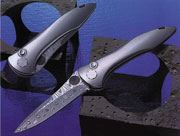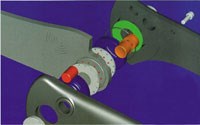Manufacturing Technology Keeps Knife Company On The Cutting Edge
'While most companies are dealing in thousandths of an inch, we're dealing in tens of thousandths. That's a lot more complex.'
Share




TiNives (Fortson, Georgia) produces 5- to 7-ounce knives that feature a blend of balance, precision and innovation. "Our first product, which we call the Zero Play knife, was introduced at the Blade Show in Atlanta in 1998," says TiNives president and owner Scott Self. "While most folding knives feature about 20 parts, ours has more than 100. In addition, our first knife featured more than half a dozen innovations that the industry had never seen before."
TiNives knives are complex to design and machine, Mr. Self explains. "It takes more than 900,000 lines of code to produce one of our knives."
The button mechanism that opens the knife is extraordinarily smooth, pivoting on 84 ceramic balls that have a finish measured in tens of thousandths of an inch. "The nature of ceramic," explains Mr. Self, "is that it burnishes and polishes, so that the knife keeps getting smoother and smoother over time, without any surface removal. While most companies are dealing in thousandths of an inch, we're dealing in tens of thousandths. That's a lot more complex."
Material selection is also key. TiNives uses standard blade steel for the body and materials such as titanium and aircraft aluminum for knife handles. The knife handle features blind tapping holes, something that is difficult to do. The titanium knife handle is not only a complex sculpted shape that delivers excellent grip and feel, but it also features a textured surface etched into it, according to the company.
The complexity of TiNives' products demanded both design and machining software that was on the cutting edge. TiNives looked at a number of CAM systems. "One was priced at $30,000, and we thought it was overkill—after all, we weren't looking at machining airplanes and automobiles. As for the other, it just appeared to be very complicated program," says Mr. Self. So TiNives turned to SURFCAM software from Surfware, Inc. (Westlake Village, California). "We first saw SURFCAM at a machine shop in Florida," says Mr. Self, "and we knew almost immediately that it was the software for us. We showed them the knife we were working on, and the shop owner got on his laptop computer, imported IGES files from our Microcadam design, and two hours later showed us the texturing we wanted mapped directly onto a sculpted surface, in titanium. It was very impressive. We were literally sold on the spot. We had never seen this kind of texturing program in a CAM program."
Today the company offers half a dozen different knives in a variety of sizes and configurations, and all of its machining operations are running smoothly. "We have one texturing called the Wave, which is an American Flag waving in the breeze," reports Mr. Self. "It has something like 370,000 lines of NC code to it, and it puts the texture on top of a 3D sculpted surface."
"Let me give you another example of the type of NC work that we're doing," Mr. Self continues. "We just prototyped a double action knife in AutoCAD 2000, imported the files into our NC environment, and the very next day we had the tool paths for the inside and outside of the handle all done. By the second day we completed the programming for the blade. And on the third day we had toolpaths for all of the round parts completed. The bottom line is that in three days we took the part from start to finish, and that gives us a lot of confidence as we move forward. That's why we're talking about ramping up production from 500 pieces a month to one or two thousand."
For TiNives, like many small businesses, reliability is key. The products and technologies that it invests in must be reliable and "bullet proof," since the company can't afford any downtime. That is exactly what TiNives gets with its NC software. "We're using a three-axis milling module, we send our NC programs to a Fadal vertical machining center as well as an Excel milling machine, and in two years we have never had a problem, not once," says Mr. Self. "We often run our machines from 7 in the morning until midnight, and we have never had to get any type of support from Surfware. We have never had a problem."
Related Content
Can ChatGPT Create Usable G-Code Programs?
Since its debut in late 2022, ChatGPT has been used in many situations, from writing stories to writing code, including G-code. But is it useful to shops? We asked a CAM expert for his thoughts.
Read More6 Machine Shop Essentials to Stay Competitive
If you want to streamline production and be competitive in the industry, you will need far more than a standard three-axis CNC mill or two-axis CNC lathe and a few measuring tools.
Read MoreTips for Designing CNC Programs That Help Operators
The way a G-code program is formatted directly affects the productivity of the CNC people who use them. Design CNC programs that make CNC setup people and operators’ jobs easier.
Read MoreCan AI Replace Programmers? Writers Face a Similar Question
The answer is the same in both cases. Artificial intelligence performs sophisticated tasks, but falls short of delivering on the fullness of what the work entails.
Read MoreRead Next
5 Rules of Thumb for Buying CNC Machine Tools
Use these tips to carefully plan your machine tool purchases and to avoid regretting your decision later.
Read MoreRegistration Now Open for the Precision Machining Technology Show (PMTS) 2025
The precision machining industry’s premier event returns to Cleveland, OH, April 1-3.
Read MoreBuilding Out a Foundation for Student Machinists
Autodesk and Haas have teamed up to produce an introductory course for students that covers the basics of CAD, CAM and CNC while providing them with a portfolio part.
Read More







































